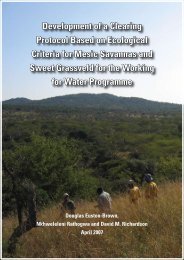Metsi Consultants - DWA Home Page
Metsi Consultants - DWA Home Page
Metsi Consultants - DWA Home Page
You also want an ePaper? Increase the reach of your titles
YUMPU automatically turns print PDFs into web optimized ePapers that Google loves.
Report No 678-F-001<br />
METSI CONSULTANTS: SUMMARY OF MAIN FINDINGS FOR PHASE 1 DEVELOPMENT<br />
Table 7.1 Hydrological summary for the Design Limitation Scenario. Shaded<br />
sites represent reaches immediately downstream of Phase 1 dams.<br />
MCM a -1 = millions of cubic meters of water per annum.<br />
IFR Site Historical MAR Design Limitation Scenario<br />
MCM a -1 MCM a -1 As % of MAR<br />
1 87 35 40<br />
2 554 184 33<br />
3 774 315 41<br />
4 1572 832 53<br />
5 1924 Minimum degradation<br />
6 3330 Minimum degradation<br />
7 355 126 35<br />
8 592 254 43<br />
7.2. BIOPHYSICAL CONSEQUENCES<br />
Degradation of the rivers from their present condition would be noticeably greater than for the Minimum<br />
Degradation Scenario but less than for the Treaty Scenario. In Reaches 1, 2, 3 and 7 severe (40-80%) to critically<br />
severe (80-100%) changes are expected to the channel or riverbed. The predicted biological responses to<br />
physical change are generally more muted, with those most directly linked to the physical changes showing the<br />
greatest response. Substrata are expected to be less well-sorted, so that physical heterogeneity of the riverbed<br />
would be reduced. Thus, the diversity of physical habitats would be gradually lost, and many plant and animal<br />
species that depend on well-sorted, scoured substrata are expected to decline or disappear from the system.<br />
Physical changes are anticipated to be most apparent in the reach downstream of Katse Dam, followed by the<br />
reach at Paray and those downstream of Matsoku Weir and Mohale Dam. Loss of mobilisation of nutrients and<br />
fine sediments is expected to lead to substantial build-ups of mud in the rivers, sedimentation of clean cobble<br />
areas, loss of both numbers and depths of pools and a decline in water quality. Thus, in pools, the loss of water<br />
depth would be exacerbated by them being turbid and nutrient-rich more often than at present, with an increased<br />
likelihood of algal blooms, particularly in the reaches downstream of the dams, where there could be critically<br />
severe (80 ->100%) increases in algal occurrences.<br />
Different vegetal species in the wetbank zone, nearest to the open water, would reflect negligible, low or<br />
moderate (0-40%) increases or decreases in abundance at all sites, but changes in the outer drybank zone would<br />
be more extreme.<br />
Impacts on the instream fauna would be most severe for fish. The Maluti Minnow and rainbow trout are predicted<br />
to drastically decline in abundance and possibly to disappear from the Matsoku reach downstream of the weir. All<br />
other native fish species, except the Orange River mudfish, would also show a severe (40-80%) loss of numbers<br />
downstream of Katse and Mohale Dams, with a less drastic reduction elsewhere in the system. The Orange River<br />
mudfish would exhibit a negligible to low (1-20%) increase in numbers.<br />
Most shifts in invertebrate abundance would be negligible to moderate (0-40%), but there would be more extreme<br />
changes (up to 75%) in the abundance of blackflies. Among those, the most probable change of greatest social<br />
significance is a predicted 40-60% increase in numbers of Simulium nigritarse downstream of Mohale Dam.<br />
38

















